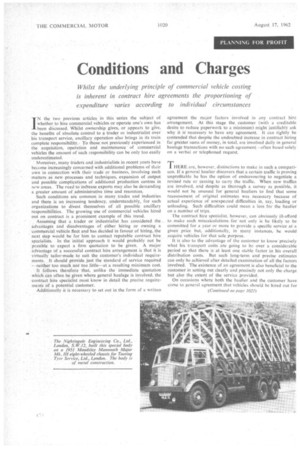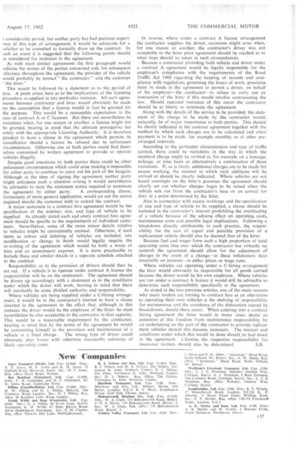Conditions and Charges
Page 64

Page 67

If you've noticed an error in this article please click here to report it so we can fix it.
Whilst the underlying principle of commercial vehicle costing is inherent in contract hire agreements the proportioning of expenditure • variesaccording to individual circumstances TN the two previous articles in this series the subject of whether to hire commercial vehicles or operate one's own has been discussed. Whilst ownership gives, or appears to give, the benefits of absolute controlto a trader or industrialist over his transport service, ancillary operation also brings in its train. complete responsibility. To those not previously experienced in the acquisition, operation and maintenance of commercial vehicles the amount of such responsibility can be only too easily underestimated.
Moreover, many traders and industrialists in recent years have become increasingly concerned with additional problems of thoir own in connection with their trade or business, involving such matters as new processes -and techniques, expansion of output and possible complications of additional production centres in new areas. The reed to increase exports may also be demanding
a greater amount of administrative time and resources.
Such conditions are common in many ,trades and industries and there is an increasing tendency, understandably, for such organizations to divest themselves of all possible ancilrary responsibilities. The growing use of commercial vehicles hired out on contract is a prominent example of this trend.
Assuming that a trader or industrialist has considered the , advantages and disadvantages of either hiring or owning a . commercial vehicle feet and-has decided in favour of hiring, the next step would be for him to contact reputable contract hire specialists. In the initial approach it would probably not be possible to expect a arm quotation to -be given. A major advantage of a successful contract hire arrangement is that it is virtually tailor-made to suit the customer's -individual requirements. It should provide just the standard of service required —neither too much nor too little—at a resulting minimum cost.
It follows therefore that, unlike the immediate quotation which can often be given where general haulage is involved, the
• contract hire specialist must know in detail the precise requirements of a potential customer. Additionally it is necessary to set out in the form of a written
agreement the major factors involved in any contract hire arrangement. At this stage the customer (with a creditable desire to reduce paperwork to a minimum) might justifiably ask why it is necessary to have any agreement. It can rightly be contended that despite the undoubted increase in contract hiring far greater sums of money, in total, are involved daily in general haulage transactions with no such agreement—often based solely on a verbal or telephoned request.
THERE are, however, distinctions to make in such a comparison. If a general haulier discovers that a certain traffic is proving unprofitable he has the option of endeavouring to negotiate a revised rate or ceasing to carry the traffic. When new traffics are involved, and despite as thorough a survey as pos.Sible, it would not he unusual for general hauliers to find that some reassessment of original estimates was necessary because of actual experience of unexpected difficulties in, say, loading or unloading. Such difficulties could mean a loss for the liaulier on a number of trips.
The contract hire spetialist, however, can obviously, ill-afford to .make such .miscalculations -for not only is he likely to he committed for a year or more to provide a specific service at-a given price but, additionally, in rpany instances, he would
acquire vehicles for that sole purpose. .
It is also to the advantage of the customer to know precisely what his transport costs are going to be over a considerable period so that there is at least one stable factor in his overall distribution costs. But such long-term and precise estimates can only be achieved after detailed examination of all the factors involved. The existence of an agreement is also beneficial to the customer in setting out clearly and precisely not only the charge but also the extent of the service provided.
On occasions where both the haulier and the customer have come to general agreement that vehicles should be hired out for (Continued on page 1021)
t considerable period, but neither party has had previous experi:nce of this type of arrangement, it would be advisable for a iolicitor to be consulted to formally draw up the contract. In ;uch an event it is suggested that the following points should )e considered for inclusion in the agreement.
As with most similar agreements the first paragraph would ndicate the names of the parties concerned and, for subsequent
.eference throughout the agreement, the provider of the vehicle would probably be termed "the contractor" and the customer the hirer."
This would be followed by a statement as to the period of hire. A point arises here as to the implications of the licensing procedure as applied in any particular instance. All such agree ments between contractor and hirer would obviously be made on the assumption that a licence would in fact be granted for the purpose. This would be a reasonable expectation in the case of contract A or C licences. But there can nevertheless be occasions when, for one reason or another, a licence might not be granted. bearing in mind that the ultimate prerogative lies solely with the appropriate Licensing Authority. It is therefore prudent to have a clause in the agreement which permits its cancellation should a licence be refused due to unforeseen circumstances. Otherwise one or both parties could find themselves committed by written agreement to provide or operate vehicles illegally.
Despite good intentions by both parties there could be other unforeseen circumstances which could arise making it impossible for either party to continue to carry out his part of the bargain. Although at the time of signing the agreement neither party might anticipate such a situation arising it would nevertheless be advisable to state the minimum notice required to terminate the agreement by either party. A corresponding clause, fortunately of more general application, would set out the notice required should the customer wish to extend the contract. A major statement in a contract hire agreement would be the specification of the number, size, and type of vehicle to be supplied. As already stated each and every contract hire agreeMent should be specific to the requirements of individual customers. Nevertheless, some of the more minor details relative to vehicles might be conveniently, omitted. Otherwise, if such items as colour and lettering of vehicles are included, any mOdification or change in finish would legally require the re-writing of the agreement which would be both a waste of time and an unnecessary expense. It is more practicable to include these and similar details in a separate schedule attached to the contract.
Responsibility as to the provision of drivers should then be set out_ If a vehicle is to operate under contract A licence the responsibility will be on the contractor. The agreement should be drawn up accordingly with a statement as to the conditions under which the driver will work, bearing in mind that there will inevitably be some divided authority and responsibility.
Where vehicles are being supplied under a C-hiring arrangement, it would be in the contractor's interest to have a clause Inserted in the agreement to the effect that, although in this instance the driver would be the employee of the hirer, he must nevertheless be also acceptable to the contractor in that capacity. This would be a reasonable requirement by the contractor, bearing in mind that by the terms of the agreement he would be committing himself to the provision and maintenance of a vehicle at a fixed charge. The wrong type of driver could obviously play havoc with otherwise reasonable estimates of likely operating costs. In reverse, where under a contract A licence arrangement the contractor supplies the driver, occasions might arise when, for one reason or another, the contractor's driver was not acceptable to the hirer prior agreement should be reached as to what steps should be taken in such circumstances.
Because a contractor providing both vehicle and driver under a contract A agreement would be legally. responsible for the employee's compliance with the requirementsof the Road Traffic Act 1960 regarding the keeping ofrecords and compliance with regulations governing the hours of work, provision must be made in the agreement to permit a driver, on behalf of his employer—the contractor—to refuse to carry out an instruction of the hirer if this would involve contravening the law. Should repeated instances of this occur the contractor should be at liberty to terminate the agreement.
Along with the details of the service to be provided, the statement of the charge to be made by the contractor would, .naturally, be of major importance to both parties. This should he clearly indicated in the contract agreement together with the method by which such charges are to be calculated and when payment is to be made, for example monthly or at other prearranged intervals.
According to the particular circumstances and type of traffic carried, there could be variations in the way .in which the standard charge might be arrived at, for example on a tonnage, mileage, or time basis or alternatively a combination of these variations. If, as is likely, additional charges are to be made for excess working, the manner in which such additions will be arrived at should be clearly indicated. Where vehicles are not based overnight on the hirer's premises the agreement should clearly set out whether charges begin to be raised when the vehicle sets out from the contractor's base or on arrival for duty at a point determined by the hirer.
Also in connection with excess workings and the specification of size and type of vehicle to be supplied, a Clause should be included in the contractor's interest prohibiting the overloading
of a vehicle because of the adverse effect on operating costs, maintenance costs and possible legal. implications. Following a
breakdown directly attributable to such practice, the responsibility for the cost of repair and possible provision of a replacement vehicle should also be deemed that of the hirer.
. Because fuel and wages form such a high proportion of total operating costs (but over which the contractor has virtually no control) the agreement should allow for the adjustment of charges in the event of a change—in these inflationary days invariably an increase—in either prices or wage rates.
Where vehicles are operating under a C-hiring arrangement the hirer would obviously be responsible for all goods carried because the driver would be his own employee. Where vehicles are run under a contract A licence it would still be advisable to determine such responsibility specifically in the agreement.
As stated in the two previous articles, one of the main reasons why many traders are turning to contract hire as an alternative to operating their own vehicles is the shelving of responsibility for maintenance and the avoidance of the dislocation caused by breakdowns, should these occur. When entering into a contract hiring agreement the hirer would in many cases desire an extension of this freedom from maintenance responsibility by an undertaking on the part of the contractor to provide replace
ment vehicles should this become necessary. The manner and conditions under which this would be done should ..be laid down in the agreement. Likewise the respective responsibility for
insurance matters should also be determined. S.B.












































































































